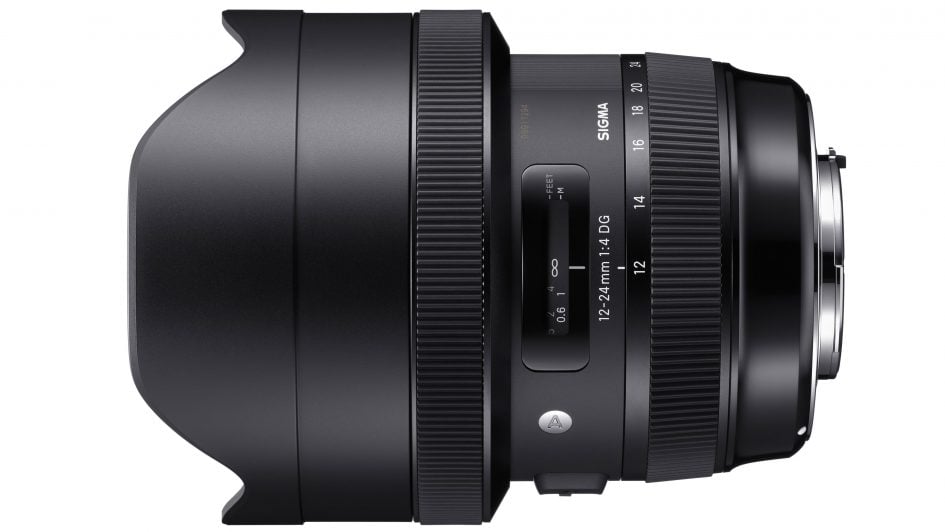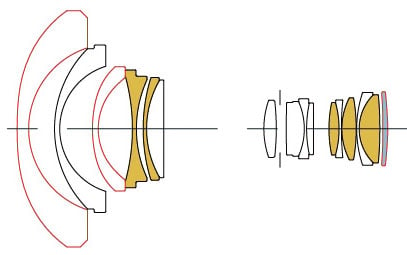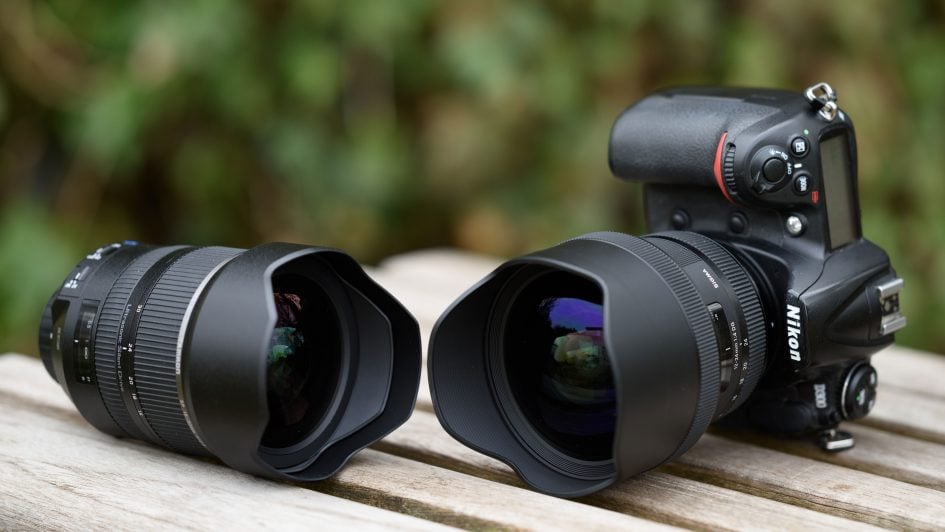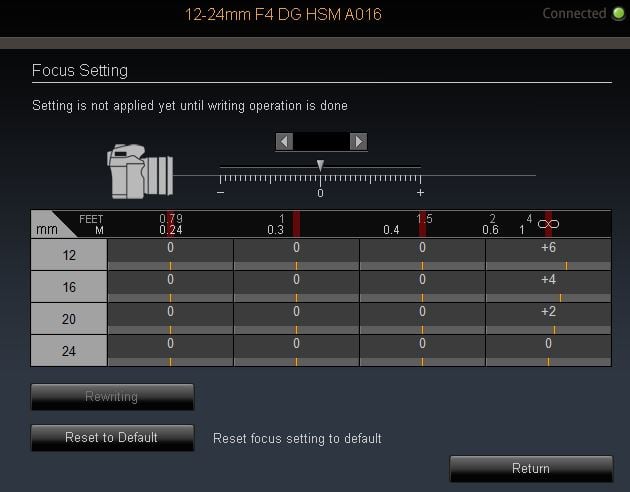Sigma 12 24mm F 4 Dg Hsm Art for Canon Review
Summary
 Sigma'due south new 12-24/4.0 zoom is a very competent lens: Its optical operation is upwardly there with the reference fifteen-30mm zoom from Tamron, it has only minor distortions and finally offers a constant f4.0 focal ratio - although f2.eight would have been even nicer. Most importantly it goes down to 12mm focal length offering a whopping 122 degrees bending of view which is only surpassed past Canon'south xi-24mm f4.0 lens at well-nigh twice the toll. So although the new Sigma is not exactly cheap it earns a Highly Recommended rating.
Sigma'due south new 12-24/4.0 zoom is a very competent lens: Its optical operation is upwardly there with the reference fifteen-30mm zoom from Tamron, it has only minor distortions and finally offers a constant f4.0 focal ratio - although f2.eight would have been even nicer. Most importantly it goes down to 12mm focal length offering a whopping 122 degrees bending of view which is only surpassed past Canon'south xi-24mm f4.0 lens at well-nigh twice the toll. So although the new Sigma is not exactly cheap it earns a Highly Recommended rating.
Purchase it now!
Check prices on the Sigma 12-24mm f4 ART at Amazon, B&H, Adorama, or Alternatively get yourself a copy of my In Camera book or treat me to a coffee! Thanks!
Sigma 12-24mm f4 Art review -
- Written by
In depth
The Sigma 12-24mm f4.0 Art is a 2x super wide-angle full-frame zoom available in mounts for Canon, Nikon and Sigma DSLRs. Announced in February 2017, it's already the 3rd generation 12-24mm model from Sigma. Sigma has done a complete optical redesign to get a abiding f/4.0 focal ratio and improve performance fitting for inclusion into Sigma's acclaimed Art serial of meridian-notch lenses. Add the improved build quality, faster AF plus compatibility with Sigma'southward USB-dock to fine melody various characteristics of AF, plus if you alter bodies, employ the MC-11 mount converter for Sony Due east-mount or pay to have the mount swapped for your new system and it's clear Sigma too wants more money for the new lens: 1600 USD/EUR is a hefty marking-up of 100% over the electric current street cost of the 2nd generation 12-24mm four.5-5.6 Two DG HSM.
To discover out how the new Sigma 12-24mm f4.0 Art performs I tested it confronting my reference lens in this segment, the Tamron 15-30mm f2.8 VC, on the enervating D810 body. So if yous're shopping for a ultra broad-bending zoom, you've come up to the correct place!

Facts from the itemize
As usual I'll have a wait at the technical data commencement. I've rated the features with a [+] (or [++]), when it'due south improve than average or even country of the art, a [0] if information technology's standard or just average, and [-] if in that location's a disadvantage. I'll compare it generally with its predecessor, the Sigma 12-24/4.5-five.6 (the "predecessor" for short) and the Tamron 15-30/two.8 VC (the "Tamron" for short). Size and weight is for the Nikon mountain version.
Size (diam. ten length): 102 ten 130mm (four.0 x 5.1in) including the built-in lens hood. Zooming does not change the length of the lens equally with its predecessor and the contest. The predecessor is smaller at 85 10 118mm with lens hood. The Tamron is 98 x 143mm with the built-in hood. [0]
Weight: 1130g (39.9 oz.). The predecessor is a meager 670g and the Tamron is 1050g. [0]

Optics: 16 elements in 11 groups which is a bit less than the 17/13 of the predecessor . The Tamron has xviii elements in xiii groups. The lens has six (extra) low dispersion and three aspherical elements. "Super-Multi-Layer" coating should reduce flare and ghosting. [+]
Closest focus distance/max. magnification: 0.24m (0.8ft) / 1:four.9 compared to 0.28m (0.9ft) / one:6.4 with its predecessor and 0.28 / 1:v.0 with the Tamron. The magnification of the new Sigma is quite good but yous take only 6cm of working distance. [+]
Filter-thread: None of the ultra broad-angle zooms from Sigma, Tamron, Nikon or Catechism offer a filter-thread. Their bulbous forepart elements foreclose that. So you lot need to get some non-standard mounting system and a new set of filters. [-]
Image Stabilization: No. Only the Tamron offers prototype stabilization in a wide-angle zoom. [0]
Machine Focus: HSM (Hyper Sonic Motor), so it also works on camera bodies which don't have an AF-drive built in similar Nikon'due south D3x00/v×00. Manual-focus override is by simply turning the focus ring. Same with the competition. But the new Sigma allows y'all to alter focus fine-tuning at iv focal lengths and iv distances with the USB-dock. [+]
Covers total frame/FX or smaller = very expert. Same with the competition. [+]
Price: around 1600 USD / 1550 EUR (incl. 19% VAT), 100% more expensive than its predecessor which can be had for effectually 750 EUR. The Tamron currently sells for 1000 EUR. But to put the price of the new Sigma in perspective: The Nikon fourteen-24/2.8G is at 1800 EUR and the Canon 11-24/iv.0 L USM costs a whopping 3000 EUR. [0]
Comes with a dainty padded lens instance and a strap. The lens hood is congenital in and cannot be removed which is less practical for cleaning the bulbous forepart element. Another slight disadvantage is that the front lens-cap does non arrest in place when mounted: it does fit tighter than the the like hoods from Nikon or Tamron but can work itself off when it rubs against your clothes. Samyang has shown with the 12mm f2.viii fisheye that you withal can built a proper locking mechanism for this type of lens-cap. Samyang besides has a detachable lens shade which makes it far easier to clean the outer parts of the front element. So here is something the other manufacturers should remember about. Btw.: When you use the built-in wink the shadow of the lens hood is prominently visible at the lesser of the image at any focal length. [0]
Distance information is relayed to the camera, so the Nikon body can do all the advanced exposure-related stuff with this lens. Same with the competition. [+]
Aperture ring: no. Same every bit with all the other alternatives. [0]
Sealing: A rubber grommet at the lens-mountain. [+]
The score in the "features-department" is 1[-]/6[0]/6[+]. This is quite skillful. Technically the only existent downside is the missing filter-thread. And a bit surprising is the price: It's twice every bit expensive every bit its predecessor and likewise costs 60% more than than the Tamron which offers a constant f2.eight aperture plus epitome stabilization. But the lens is still cheaper than the alternatives from Nikon or Canon. Size and weight might come up as a shock to someone used to smaller lenses. Only it is par for the form for a modern ultra broad-angle zoom.
Here is the angle of view that the Sigma covers with its 2x zoom:

To a higher place: Sigma 12-24/4.0 Art coverage on Nikon D810 (FF/FX) body at 12mm (left), at 24mm (correct)
Following is the coverage of the Tamron 15-30mm zoom. This is what the missing 3mm at the brusque cease and the additional 6mm at the long terminate look like:

Higher up: Tamron 15-30/2.8 VC coverage on Nikon D810 (FF/FX) body at 15mm (left), at 30mm (right)
Alternatives
- Nikon has the 14-24mm f2.8G ED. Information technology got a Highly Recommended in 2013 and costs around 1900 USD / 1800 EUR. See my Nikon 14-24mm f2.8G review.
- From Sigma at that place'southward still their 12-24mm f4.v-5.half dozen Two DG HSM for around 950 USD / 750 EUR as long as supply lasts.
- Canon has the Canon EF 11-24mm f4.0 Fifty USM from 2015 which is the World'southward widest rectilinear full-frame zoom with a street price around 2700 USD / 3000 EUR. It earned a Highly Recommended in Gordon's Canon EF 11-24mm f4L USM review.
- Tamron offers the just stabilized zoom in this group: the Tamron 15-30mm f2.8 Di VC USD for about 1200 USD / 1000 EUR. Information technology earned a Highly Recommended in my Tamron 15-30/2.8 VC review.

Above left: Tamron fifteen-xxx/2.8 VC, above right: Sigma 12-24/4.0 Fine art
Focus
Focus accuracy and repeatability is disquisitional to consistently produce sharp shots. Repeatability (the accurateness of focus on the same subject subsequently repeated focus-conquering) of this lens is very expert (measured 99.i% in Reikan FoCal) with no outliers over a series of 40 shots under strictly controlled exam weather. And in that location is virtually no performance variation whether the lens focuses from infinity or from a closer distance. Under real-life shooting conditions the lens behaved a chip dicey at the short terminate with target distances of 10m and beyond: In a number of cases the lens focused too close in phase-detect AF which did not immediately testify upward in the center of the image because of the large dof at 12mm and f4.0. But the outer areas became visibly less sharp in these cases. As in-photographic camera AF fine-tuning was perfect for the longer focal lengths I had to rely on the USB-dock to make specific adjustments for 12mm. I'd rather wish that the lens came properly adjusted right out of the box.

Above: Sigma Optimization Pro software allows AF fine-tuning for 16 dissimilar combinations of distance and focal length.
At 24mm focal length the lens focuses without hunting in effectually 0.6 sec from infinity to 0.24m, which is quite fast. The focus ring has no slack/play between its motion and the focus-action and a throw of 130 degrees which is more than than enough for manual focus at f4.0. Its rubberized surface is 12mm wide and can be turned with one finger. The zoom ring turns through 80 degrees and has a 13mm broad rubber surface which is pretty small for the about important ring on this lens. It's also quite stiff, at least fresh from the manufacturing plant. Both rings turn in the same direction as Canon users are used to and Sigma did also put the focus ring at the front and the zoom band very close to the camera body. And so the handling is identical to e.g. the Canon EF 11-24mm iv.0 50 USM. Just this will not please Nikon users every bit they expect both rings to turn the other way around. Personally I also would accept preferred the zoom ring to be farther away from the body: I occasionally got my pollex stuck betwixt the zoom ring and the flash protruding from the body when turning the zoom band from 24mm towards shorter focal lengths. There is simply non much clearance between the camera body and the zoom ring.
AF-operation is pretty placidity from the exterior, and if you record video with the built-in microphone the AF-drive produces a slight hiss but there are no clicks at the start or stop of focus-movements. Very good!
Pages: one ii 3 4
Source: https://www.cameralabs.com/sigma-12-24mm-f4-art-review/
0 Response to "Sigma 12 24mm F 4 Dg Hsm Art for Canon Review"
ارسال یک نظر